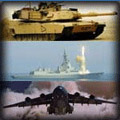flagos
Estamos de acuerdo en que innovaron demasiado, y con tanta innovacion perdieron el norte, que no era otra cosa que SER PRACTICO.
Menos mal que aun hubo personas que decidieron mantener la produccion de P-IV y deribados...
...Discrepo contigo en que el tigre haya sido inútil frente al IS-2...
El Tigre se diseño para un uso muy especifico. La punta de lanza de la division panzer... En el 44 ya no servia para ello, luego era un modelo "obsoleto", el JS-2 era el nuevo "cazador" de las puntas acorazadas y solo la pericia de las dotaciones de tigre y la impericia de las soieticas conseguian "salvar" la situacion.
Mejorarlo hubiera sido replantear el diseño desde la base. el Tigre, como bien apuntaste, nacio ya con la limitacion del arma a usar, luego cambiar el arma era rediseñar el vehiculo completamente, lo que me parece inviable. El Tgre II tenia su razon de ser, pero lo considero, cuando menos, "poco practico" para las circunstancias en que se encontraba Alemania.
...los escasos números de AUf B producidos y lo irrelevantes que fueron en combate no inquietaron a los aliados.
Coincidimos en este analisis.
...proyecto, el Leopard que era un minipantera, con componentes del PIV.
Por favor Flagos, este punto es muy interesante, ¿puedes ampliar la informacion? no recuerdo haber visto nada de ese proyecto.
Un saludo.


